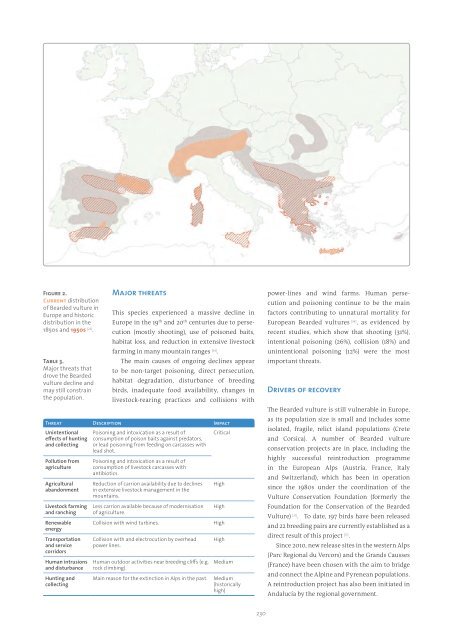130925-studie-wildlife-comeback-in-europe
You also want an ePaper? Increase the reach of your titles
YUMPU automatically turns print PDFs into web optimized ePapers that Google loves.
Figure 2.<br />
Current distribution<br />
of Bearded vulture <strong>in</strong><br />
Europe and historic<br />
distribution <strong>in</strong> the<br />
1850s and 1950s [22] .<br />
Table 3.<br />
Major threats that<br />
drove the Bearded<br />
vulture decl<strong>in</strong>e and<br />
may still constra<strong>in</strong><br />
the population.<br />
Major threats<br />
This species experienced a massive decl<strong>in</strong>e <strong>in</strong><br />
Europe <strong>in</strong> the 19 th and 20 th centuries due to persecution<br />
(mostly shoot<strong>in</strong>g), use of poisoned baits,<br />
habitat loss, and reduction <strong>in</strong> extensive livestock<br />
farm<strong>in</strong>g <strong>in</strong> many mounta<strong>in</strong> ranges [34] .<br />
The ma<strong>in</strong> causes of ongo<strong>in</strong>g decl<strong>in</strong>es appear<br />
to be non-target poison<strong>in</strong>g, direct persecution,<br />
habitat degradation, disturbance of breed<strong>in</strong>g<br />
birds, <strong>in</strong>adequate food availability, changes <strong>in</strong><br />
livestock-rear<strong>in</strong>g practices and collisions with<br />
Threat Description Impact<br />
Un<strong>in</strong>tentional<br />
effects of hunt<strong>in</strong>g<br />
and collect<strong>in</strong>g<br />
Poison<strong>in</strong>g and <strong>in</strong>toxication as a result of<br />
consumption of poison baits aga<strong>in</strong>st predators,<br />
or lead poison<strong>in</strong>g from feed<strong>in</strong>g on carcasses with<br />
lead shot.<br />
Critical<br />
Pollution from<br />
agriculture<br />
Agricultural<br />
abandonment<br />
Livestock farm<strong>in</strong>g<br />
and ranch<strong>in</strong>g<br />
Renewable<br />
energy<br />
Transportation<br />
and service<br />
corridors<br />
Human <strong>in</strong>trusions<br />
and disturbance<br />
Hunt<strong>in</strong>g and<br />
collect<strong>in</strong>g<br />
Poison<strong>in</strong>g and <strong>in</strong>toxication as a result of<br />
consumption of livestock carcasses with<br />
antibiotics.<br />
Reduction of carrion availability due to decl<strong>in</strong>es<br />
<strong>in</strong> extensive livestock management <strong>in</strong> the<br />
mounta<strong>in</strong>s.<br />
Less carrion available because of modernisation<br />
of agriculture.<br />
Collision with w<strong>in</strong>d turb<strong>in</strong>es.<br />
Collision with and electrocution by overhead<br />
power l<strong>in</strong>es.<br />
Human outdoor activities near breed<strong>in</strong>g cliffs (e.g.<br />
rock climb<strong>in</strong>g).<br />
Ma<strong>in</strong> reason for the ext<strong>in</strong>ction <strong>in</strong> Alps <strong>in</strong> the past.<br />
High<br />
High<br />
High<br />
High<br />
Medium<br />
Medium<br />
(historically<br />
high)<br />
power-l<strong>in</strong>es and w<strong>in</strong>d farms. Human persecution<br />
and poison<strong>in</strong>g cont<strong>in</strong>ue to be the ma<strong>in</strong><br />
factors contribut<strong>in</strong>g to unnatural mortality for<br />
European Bearded vultures [34] , as evidenced by<br />
recent <strong>studie</strong>s, which show that shoot<strong>in</strong>g (31%),<br />
<strong>in</strong>tentional poison<strong>in</strong>g (26%), collision (18%) and<br />
un<strong>in</strong>tentional poison<strong>in</strong>g (12%) were the most<br />
important threats.<br />
Drivers of recovery<br />
The Bearded vulture is still vulnerable <strong>in</strong> Europe,<br />
as its population size is small and <strong>in</strong>cludes some<br />
isolated, fragile, relict island populations (Crete<br />
and Corsica). A number of Bearded vulture<br />
conservation projects are <strong>in</strong> place, <strong>in</strong>clud<strong>in</strong>g the<br />
highly successful re<strong>in</strong>troduction programme<br />
<strong>in</strong> the European Alps (Austria, France, Italy<br />
and Switzerland), which has been <strong>in</strong> operation<br />
s<strong>in</strong>ce the 1980s under the coord<strong>in</strong>ation of the<br />
Vulture Conservation Foundation (formerly the<br />
Foundation for the Conservation of the Bearded<br />
Vulture) [21] . To date, 197 birds have been released<br />
and 22 breed<strong>in</strong>g pairs are currently established as a<br />
direct result of this project [17] .<br />
S<strong>in</strong>ce 2010, new release sites <strong>in</strong> the western Alps<br />
(Parc Regional du Vercors) and the Grands Causses<br />
(France) have been chosen with the aim to bridge<br />
and connect the Alp<strong>in</strong>e and Pyrenean populations.<br />
A re<strong>in</strong>troduction project has also been <strong>in</strong>itiated <strong>in</strong><br />
Andalucía by the regional government.<br />
230


